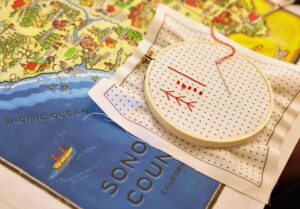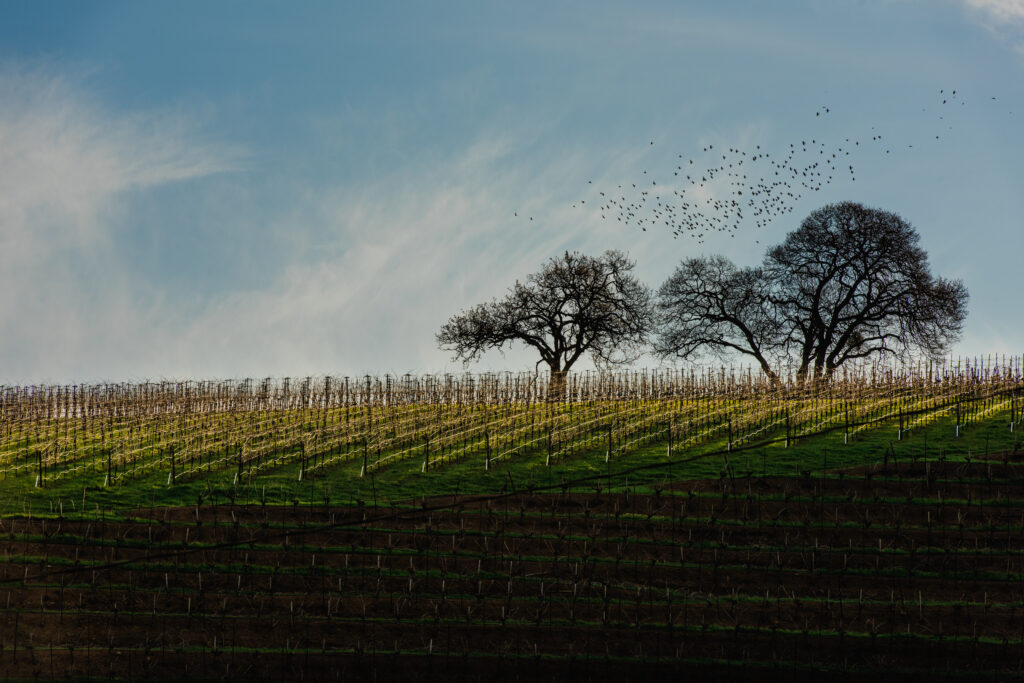In Sonoma, winter is a time of restoration.
Nourishing rains turn autumn’s golden hills and meadows to emerald velvet. Redwood forests stay shrouded in morning mist, sometimes giving way to brilliant sunshine in the afternoon. At the coast, the gray-blue ocean thrums with the rhythmic crashing of waves on otherwise quiet beaches. And all over the county, our 60,000 acres of vineyards are dormant after harvest. The leaves have dropped from the vines, exposing naked canes and trunks—slender and sleek on young plantings, thick and gnarled on the ancient vines.
In these gentle days, it’s easy to imagine that winery workers are enjoying some well-deserved rest. Except that winter signals the start of a very important annual task: pruning. More than a job, proper pruning is an art, learned over many years of hands-on experience, and it’s a key step in creating the extraordinary wines for which our region is known.
“Pruning is the first major decision we make in the vineyard for the new harvest,” says Chris Benziger of Benziger Family Winery in Glen Ellen. “It is a critical time that often gets overlooked by the public, because it happens slowly in the background, as we prune back the spent shoots of last year to focus the energy of the vine into the budding potential of the new grapes.”
For teams of vineyard workers who take on these long weeks of challenging work, pruning can also mean time for rejuvenation. Working one’s way down a row of vines, at a slower pace than at harvest time, becomes a kind of meditation, enhanced by the rich, damp smell of healthy soil, the echoes of hawks and other wildlife, and the methodical snip of the shears.
“Pruning is actually more important than harvest, because it determines the quality of the fruit for the next harvest season,” says Enrique Reyes, vineyard manager at Dutcher Crossing Winery in Geyserville. “But the crew can take their time, unlike harvest, where they need to very quickly get the fruit off the vine.”

Shaping a Future Crop
Some vineyard managers begin pruning in December, while others spread the work out through January, February—even into early March, depending on the vineyard location, the weather, and the variety of vine. Choosing when to make the first cuts of the season requires careful consideration. “When you see all the vines with leaves still even just a little green, they are still working,” says Marco Garcia, vineyard manager at Capo Creek Ranch in Healdsburg. “When all the leaves have dropped, they are shut down. If you cut before they’re dormant, you’ve broken them.”
It can be a delicate decision, since any surprise frost or rain can damage freshly pruned vines, too. “Mother Nature has the final word,” says Chris Benziger.
Pruning dictates how heavy a crop a vine will bear in the coming season, and more grapes are not always the best choice. “There are so many things to think about as you go,” says Garcia. “Every vine is individual, like a person. So you look at each one — this vine looks a little bit weak, so it needs a little less fruit. This vine looks strong, so it can handle more spurs.”


Pruning sets the course for a vine’s success—even decades into the future. “Visitors don’t understand how important the pruning is,” says Capo Creek Ranch owner Bob Covert, who often shepherds winery guests into the vineyards, which span 20 acres of Dry Creek Valley flats and hillsides. “I stop by our old-vine Zinfandels and then a couple of our new plants and talk about how they’re pruned differently to establish certain habitats. We’re creating the shape that is going to last a lifetime, so we have to ask ourselves, ‘Do we want a little more crop, or a little less crop?’ Everyone is fascinated by just how much you’re trying to accomplish with pruning.”


Fifty Vines an Hour
“Our crews run between 15 to 20 folks, and they have been with us for decades,” says Chris Benziger, who runs vineyards on Sonoma Mountain, in the Russian River Valley, and along the Sonoma Coast. “It is important to have that institutional knowledge,” he says, “because with pruning we are looking backward to predict the future.”
At Dutcher Crossing Winery, Reyes usually sends out a crew of ten in January, wrapping things up in about two weeks across the winery’s 35 acres. Meanwhile, just three workers manage the boutique vineyards at Capo Creek, taking about six weeks to complete the meticulous job. They start with heartier, later-ripening vines to protect more delicate ones from unexpected frost.
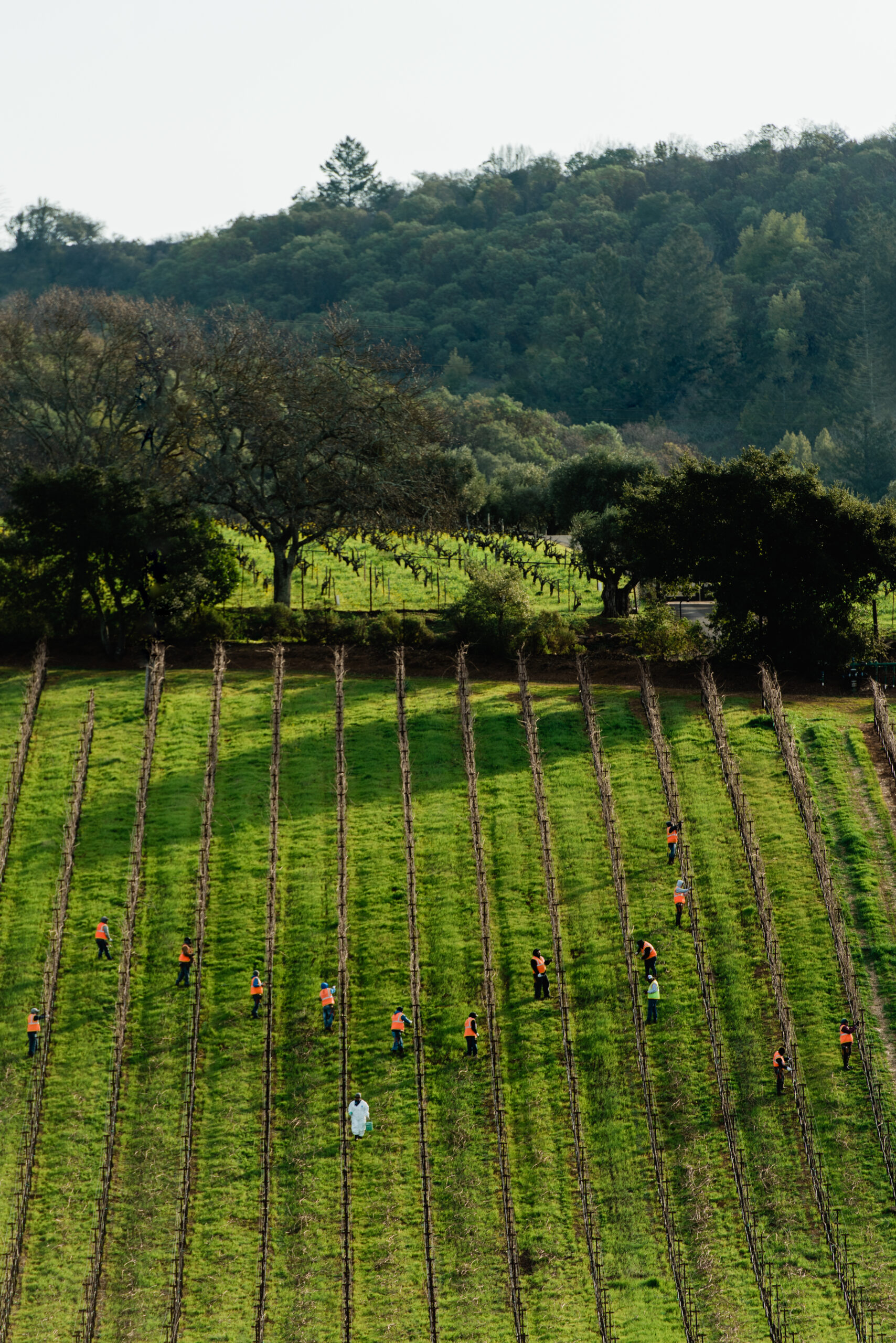
A talented pruner can tackle 40 to 50 vines per hour, even as he or she takes the time needed to study each vine. Most wineries encourage crews to take frequent breaks from what is extraordinarily demanding work on hand, arm, and back muscles. And many crews organize communal lunches with barbecues or plancha-fired tacos prepared right in the vineyard, next to the ever-growing piles of freshly cut canes.
“Of course, we still do have to keep a time sequence within a vineyard block,” Covert explains. “Once you’ve started, you want to finish, because you set the tone for when you’re going to have budbreak and fruit. You want an even maturation.”
Garcia has been pruning for 18 years, and says he is still learning, particularly as the weather and climate evolves. “You have to have experience, especially to prune the older vines,” he says. “You need to know how many spurs you can leave and still get ripening – the old vines are more secretive about what their plans are for the coming year. To be perfect in pruning takes a long, long time.”
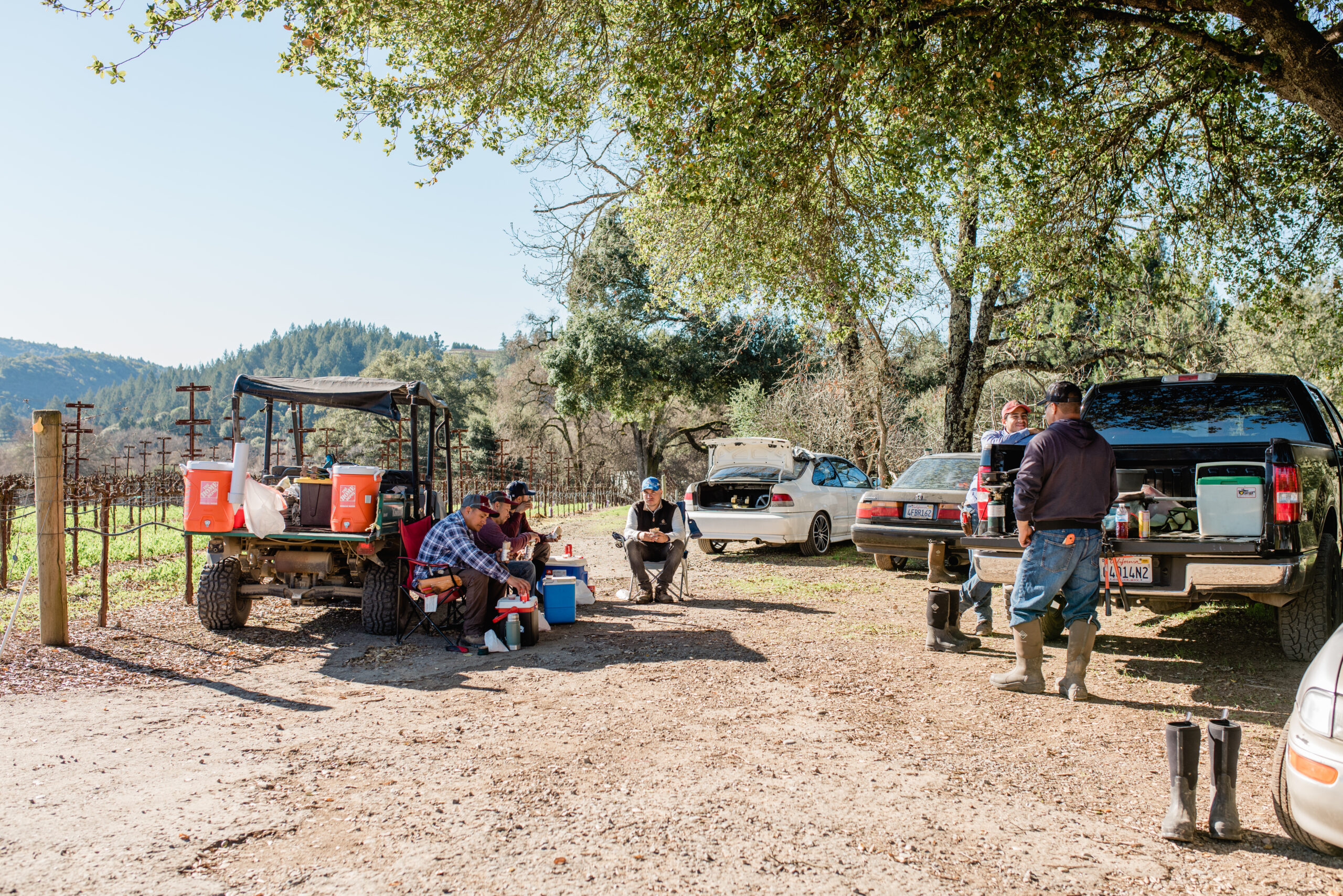
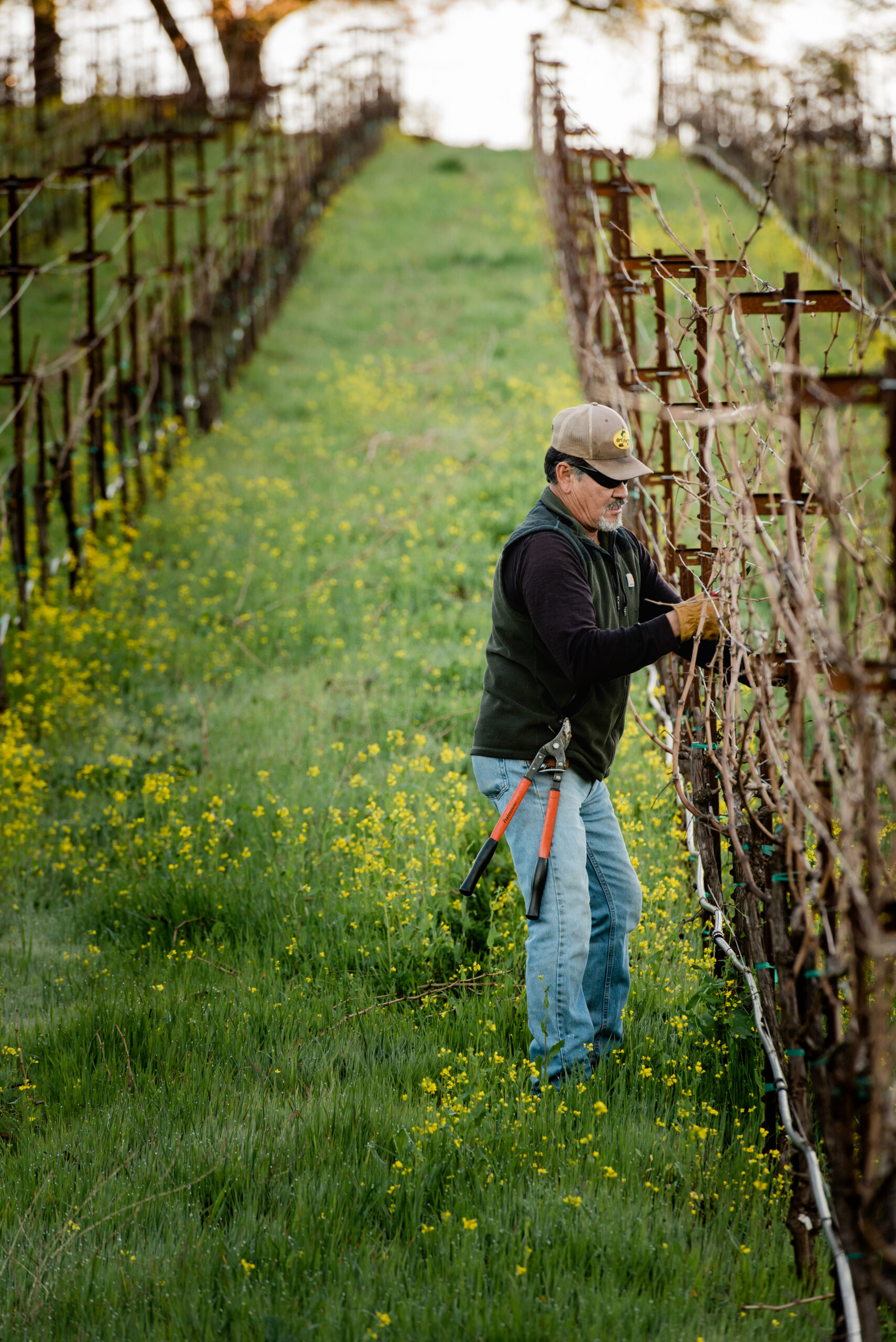
Soaking Up Nature
For those who understand the season, right now is one of the most beautiful and exciting times of the year in the vineyard. “Compared to harvest, pruning is totally different,” says Garcia. “It’s kind of relaxed, and you really enjoy it. Everywhere you look is green. We have such great views from Capo – Dry Creek Valley, and Mount Saint Helena is right there.”
“We might get fog the morning, afternoon sun, sometimes maybe a little bit of rain – it’s one of the best times to work. You start your morning with a coffee, play some music you love, and soak up the beauty of nature… Oh my goodness, it’s the best job in the world.”


Among the Vines: Pruning Tours and Tastings
Beltane Ranch: Each year, usually in late February or early March, the historic estate in Glen Ellen hosts an all-day pruning festival, including live demonstrations, a pruning contest, and mariachi music. 11775 Sonoma Hwy, Glen Ellen. 707-833-4233. Check for date and details at beltaneranch.com
Benziger Family Winery: The Benzigers have farmed bio-dynamically for 21 years. The estate winery offers vineyard tours and tastings, where you may see pruning crews in action, typically through late February or so. 1883 London Ranch Road, Glen Ellen. 707-935-3000, benziger.com
Capo Creek Ranch: On a tour and tasting, admire old-vine Zinfandel planted over 40 years ago, and compare them with hillside vines planted in 2016. Pruning is done by a small crew over about six weeks, often beginning in late January. 7171 West Dry Creek Road, Healdsburg. 707-608-8448, capocreekranch.com
Dutcher Crossing Winery: Guests are welcomed to a 1900s-style farmhouse and 35-acre estate winery where pruning crews will be in action typically through mid-February (call for info). Bring your own picnic, and play a game of pétanque on the winery’s courts. 8533 Dry Creek Road, Geyserville. 707-431 2700, dutchercrossingwinery.com
Kunde Family Winery: The Kunde family have farmed the rolling hills of Kenwood for five generations. Special vineyard hikes allow guests to see the vines up close in pruning season. They offer dog hikes in the vineyards, too. 9285 Highway 12, Kenwood. 707-833-5501, kunde.com





